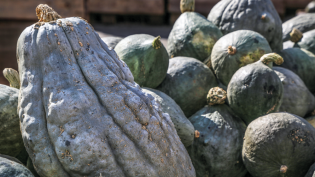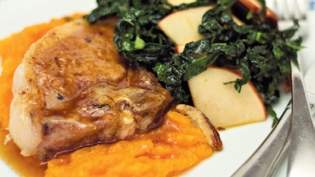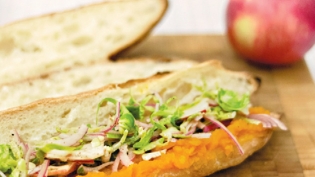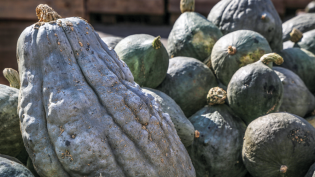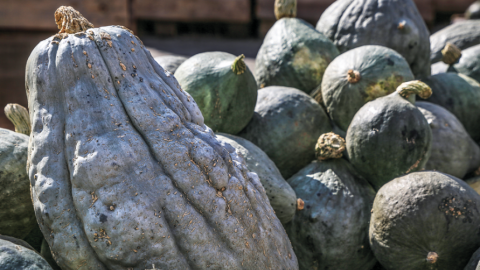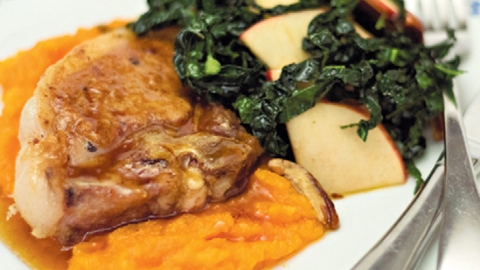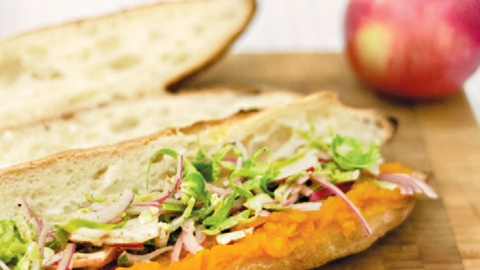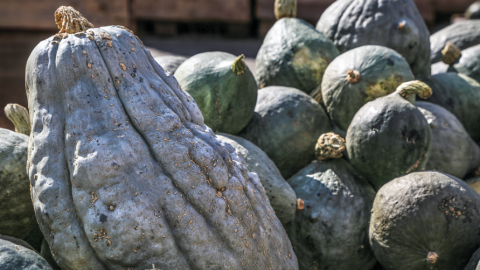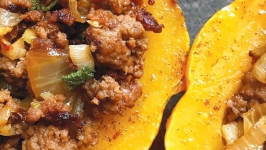Welcome the Big Squashes of Winter!
I fall victim to the winter blues. It starts as just wanting to curl up on a warm sofa and watch the snow falling outside. It devolves into not wanting to go out at all. Then on to realizing that there is no fresh food in the house and eventually to removing a frozen pizza from the depths of the freezer and eating it by myself standing over the sink.
To combat these tendencies, I’ve tried different things but none as successful as getting up, going to market and buying the biggest, weirdest squash I can find. This works for me for three reasons:
One, large squashes are so, so much food, and to eat all that food I need to have friends over for dinner. Friends not only bring big appetites, but also bring conviviality and socialize with me, creating the secondary benefit of mitigating my cold weather hermit crabbiness.
Two, when I’m feeling daunted by the winter blues it takes a lot to work up the energy to cook. I will make grand plans to make an elaborate meal, and as soon as I’m done writing the prep list, I am suddenly confronted by a feeling of “Meh, I can’t be bothered.” But with a squash, my favorite way to cook it is to crack it in half, scoop out the seeds, and roast (cut side down) until the flesh is fully tender. Even in my most sedentary state, I can achieve that. By the time I feel unmovable, the sweet smell of roasting squash is filling the kitchen and encouraging me to make something else. Just like that, I’m moving and inertia is working in my favor.
Three, the leftovers are incredibly easy to repurpose into different meals after my friends are gone.
Simply carrying such a squash home from the market, cradling it in my arms like a baby, fills me with the anticipation of friends over and the oven on. Additionally, buying the biggest, weirdest-looking one seems to make farmers happy. The bane of the fall market season is hauling one’s strangely shaped squash darlings back and forth as such cucurbits get no love from market goers. True, they are big and unruly and, if priced by the pound, cost more than people usually tend to spend. And they are worth every penny because the flavor is deep and intense and because there is so much food and cooking efficiency underneath that bumpy skin.
My favorite varieties are blue hubbard, sibly, red kuri, buttercup, galeux d’eysines and pink banana. They each taste slightly different but all have a drier flesh than the always-favored butternut or spaghetti. These are also mostly heritage varieties and buying them helps ensure that we are not on a road to an acorn squash monocrop apocalypse.
No matter the type of squash you chose, with the exception of spaghetti squash, the basic technique is the same:
Heat the oven to anywhere between 325° and 400°F. The higher the temperature, the faster it will cook. There is little danger of burning the squash because the skin will protect it, but it is possible so keep an eye out.
Cut the squash in half and remove the seeds. It can be a trick to get a small knife through a big squash, so use the longest knife you have. I will sometimes shave a bit of one side off to create a flat side to rest on the cutting board, making the squash far more cooperative. Then just start slicing. If the knife gets stuck lift the squash, with one hand on the side of the squash and the other on the knife handle, and whack it on the cutting board while applying downward pressure on the knife. It is loud and a bit nerve-wracking, but it will help to cause the squash to literally crack in half. Don’t worry if the edges aren’t even; it will all look the same after the squash is cooked.
At this point you can save the seeds to roast for a snack if you like. For me, sometimes adding that step makes the day feel too full, so I’ve been known to add the seeds to the compost and not look back. You do you.
Rub the squash with a bit of oil and place cut side down on a foil-lined baking sheet. Place the squash in the oven and bake until the flesh collapses underneath a prodding finger. At this point the squash will be golden brown and bubbling around the sides. It should look inviting and yield easily when poked.
Remove from the oven and allow to cool. Scoop the flesh away from the skin and then choose your own adventure for what is next. More often than not, I blend that flesh with some brown butter to make a silky smooth purée and serve it with something spicy or salty. It is a show stopper that replaces grits or mashed potatoes at many a wintery dinner party.
The warmth of that conviviality will temper the seemingly unavoidable “pizza-over- the-sink” nights. And converting the leftovers into a soup or schmearing on sandwiches will stave off the sad meals lurking in the back of the freezer.



